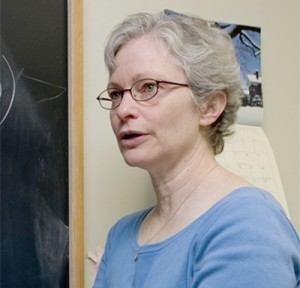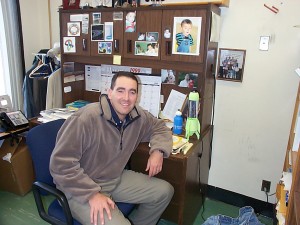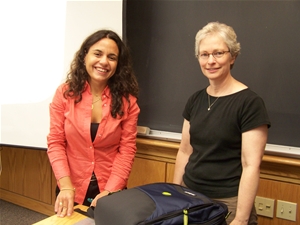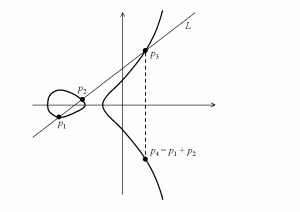Algebraic Geometry at Park City Mathematics Institute (https://pcmi.ias.edu/application-ugss)
Student Talk Series: Erik Bollt, Clarkson University, December 4th, Olin 268 @ noon
Title: Diseases, Fame and Merit – Various Outbreaks on Social Networks
Abstract: Dynamical Systems, Chaos theory and Complex Systems theory has some useful mathematical tools to bring to bear on problems that are very familiar to our own lives. Furthermore, social media has some really relevant large scaled data that also lends toward a modern discussion of what happens when people socially contact.
Distinguished Visiting Professor Talk Series: Sergi Elizalde, Dartmouth College, November 24th @4pm in Olin 372
Title: Consecutive patterns in permutations
Abstract: An occurrence of a consecutive pattern sigma in a permutation pi
is a subsequence of adjacent entries of pi in the same relative
order as the entries of sigma. For example, occurrences of the
consecutive pattern 21 are descents, and alternating permutations
are those that avoid the consecutive patterns 123 and 321. The
systematic study of consecutive patterns in permutations started over
a decade ago. More recently, consecutive patterns have become
relevant in the study of one-dimensional dynamical systems, and they
are useful in creating tests to distinguish random from deterministic
time series.
We show that the number of permutations avoiding the consecutive
pattern 12…m —that is, containing no m adjacent entries in
increasing order— is asymptotically larger than the number of
permutations avoiding any other consecutive pattern of length m. At
the other end of the spectrum, the number of permutations avoiding
12… (m-2)m(m-1) is asymptotically smaller than for any other
consecutive pattern.
Student Talk Series: Sergi Elizalde, Dartmouth College, November 20th, Olin 268 @ noon
Title: Lattice paths between two boundaries
Abstract: Dyck paths are lattice paths with steps N=(0,1) and E=(0,1) starting
at (0,0), ending at (n,n), and never going below the diagonal y=x.
Among the many interesting facts known about Dyck paths, one is that
the parameters ‘number of E steps at the end’ and ‘number of returns
to the diagonal’ have a symmetric joint distribution, meaning that to
each Dyck path we can bijectively associate another one where these
parameters are interchanged.
I will show that this symmetry property applies not only to Dyck
paths, but more generally to lattice paths with N and E steps that lie
between any two fixed boundaries. Finally, I will discuss how these
lattice paths are related to other objects in combinatorics, such as
matroids, semistandard Young tableaux and k-triangulations.
This is joint work with Martin Rubey.
Distinguished Visiting Professor Talk Series: Paola Sztajn, North Carolina State University, November 4, @ 4pm in Olin 372
Title: Learning from systematic descriptions of mathematics professional development
Abstract: In this talk I present emerging results from a systematic
review of publications on mathematics professional development. The
research team reviewed over 170 papers published between 1992 and 2010
to address the following research questions: What do we know about the
design and conduct of mathematics PD being studied by researchers and
how are these PD characterized in research reports? The conceptual
framework included six elements: theory, context, goals, content,
format, and activities.
Problem of the Week Instructions and This Week’s Problem
Try the Math Department Problem of the Week!
New Problems every Tuesday at 1pm!
How it Works:
- Pick up a problem sheet in the Math Department on the third floor of Olin Science
- Do the problem!
- Turn in your solution in the Math Dept. Office in Olin 380 before 5pm the following Monday.
- Every correct solution over the course of the semester gives you a chance to win a $50 Amazon Gift Card.
- Keep doing the Problem of the Week! Each correct solution adds your name to the drawing at the end of the semester!
2 correct solutions = 2 tickets in the drawing!
Problem of the Week #4:
Distinguished Visiting Professor Talk Series: Eva A. Gallardo Gutierrez, Universidad Complutense de Madrid, October 23rd @ 4pm in Olin 372
Title: Rota’s Universal Operators
Abstract: The Invariant Subspace Problem for Hilbert spaces is a long-standing question and the use of universal operators in the sense of Rota has been one tool for studying the problem. The best known universal operators have been adjoints of analytic Toeplitz operators or unitarily equivalent to them. We present many examples of Toeplitz operators whose adjoints are universal operators and exhibit some of their common properties. Some ways in which the invariant subspaces of these universal operators interact with operators in their commutants are given. Special attention is given to the closed subalgebra, not always the zero algebra, of compact operators in their commutants.
Algebra etc. Seminar: Shelby Kilmer, October 16 @ 4pm in Olin 372
Title: Random Groups at Density 1/2
Abstract: Random groups in the density model (with density 0<d<1) have
presentations with a random set of (2m-1)^{dk} relators of length k on
m generators. The classic theorem in the density model states that for
d>1/2, random groups are asymptotically almost surely trivial or
isomorphic to Z/2Z, while for d<1/2, random groups are asymptotically
almost surely infinite hyperbolic. This summer our research group
studied random groups at d=1/2 and found both infinite hyperbolic
groups and trivial groups are generic, depending on how we tuned
certain parameters.
Algebra etc. Seminar: Nathan Ryan, October 9 @ 4 pm in Olin 372
Title: Elliptic Curves: New Solutions to Old Problems
Abstract: Elliptic curves are ubiquitous in math and in number theory in particular. They are studied for their geometric, arithmetic and analytic properties. We focus on three old problems recently (partially) solved using elliptic curves: one problem is from cryptography, one is from the art world and one is from high school geometry.
Student Talk Series: Pamela Gorkin, Bucknell University; October 23rd @ noon, Olin 268

Title: The World’s Greatest Game
Abstract: Analogy pervades all our thinking, our everyday speech and our trivial conclusions as well as artistic ways of expression and the highest scientific achievements.” This quote, from George Pòlya, is from his book, “How to Solve It”. If you have a problem that you want to solve, this is the book and, possibly, the talk for you. We’ll follow Pòlya’s four-step method as we discuss questions from different areas: probability, geometry and life and, as a plus, we’ll learn to visualize something people often think is imaginary.
Bio: Pamela Gorkin is a Professor in the Mathematics Department here at Bucknell.


